Roger Ebert Symposium Explores Science Communication to Foster Empathy for the Universe, Earth, and Its Inhabitants
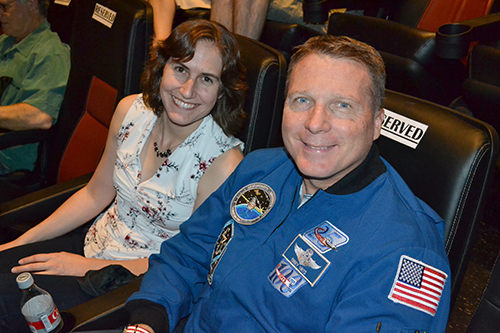
Katie Mack (left) and Terry Virts (right) before the IMAX showing of A Beautiful Planet.
October 15, 2018
The Inaugural Roger Ebert Symposium, Empathy for the Universe: Storytelling and Data Visualization, not only sought to create empathy for the entire universe, but zeroed in on our little corner of it, Planet Earth. The October 1st symposium targeted media currently at the forefront of science communication: interactive storytelling, data visualization, and, of course, video and cinema. Treating participants to a taste of the premium movie-going experience, IMAX 3D, the highlight of the day featured a screening of the IMAX release, A Beautiful Planet.
The symposium was the dream child of Donna Cox, Director of the Advanced Visualization Lab (AVL) at the National Center for Supercomputing Applications (NCSA); Tracy Sulkin, Dean of the College of Media; Chaz Ebert, CEO of Ebert Digital LLC; and Nate Kohn, Roger Ebert Film Festival director. Sponsored by their respective units, along with the IMAX theater, the symposium featured a number of speakers, interactive panels, public discussions, previews of some of the AVL’s 4K (ultra HD) 3D movie clips, and of course, the free screening of A Beautiful Planet at Savoy 16’s IMAX theater. The post-screening Q&A featured two key players in the production of the film: the primary cinematographer, former NASA astronaut Terry Virts, and the film’s director and writer, Toni Myers.
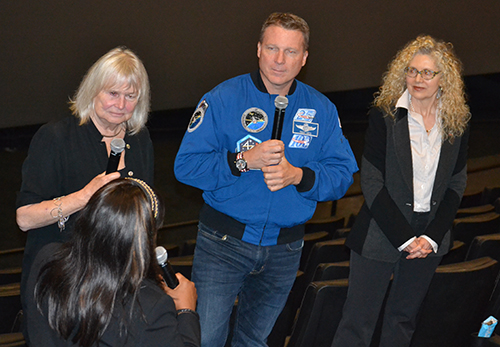
(left to right) Toni Myers, Terry Virts, and Donna Cox at the post-screening Q&A session.
Presenting throughout the day were experts in the field of scientific communication—what Chaz Ebert referred to as “an embarrassment of riches of people and intellect.” The speakers and panels focused on three emphases: Science on the Screen, Story Framing and Visualization, and Interconnectedness in Arts and Sciences. Ebert added that the trajectory for the day was to “start from above…bring it down to earth level, and then we're going to go to humanity.”
Along with Ebert, Virts, and Myers, other presenters included: the Sloan Foundation’s Doron Weber; North Carolina State University Teaching Professor Brand Fortner; North Carolina State University Physics Assistant Professor “Astro Katie” Mack; Illinois Computer Science Professor Karrie Karahalios; Illinois Journalism Professor Brant Houston; Colorado State University Professor of Animal Science, Temple Grandin; Illinois Assistant Professor of Graphic Design, Stacey Robinson; Rachel Switzky, Director of Illinois’ new Siebel Center for Design; and Illinois Associate Professor of Media and Cinema Studies, Anita Chan.
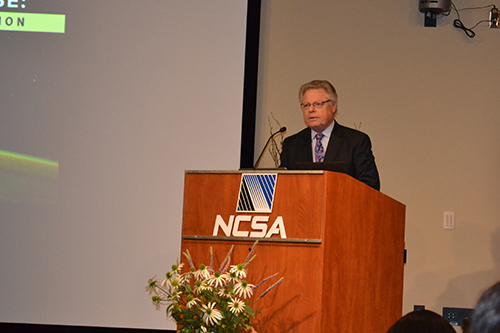
Vice Chancellor for Academic Affairs and Provost, Andreas Cangellaris, welcoming participants to the symposium.
Welcoming participants to the fledgling symposium on the behalf of the University of Illinois was Andreas Cangellaris, the Vice Chancellor for Academic Affairs and Provost, who dubbed it “an event that we can celebrate over and over again and expand it because of who we are—a comprehensive university that has all the elements to accept the challenges we face, debate them, acknowledge the fact that we can do something about it, and most importantly, set the stage to make this happen.”
Helping MC the event was Chaz Ebert, Roger Ebert’s widow and the CEO of Ebert Digital LLC, which publishes the movie review site, RogerEbert.com. During her welcoming address, she stressed our interconnectedness as members of the human race. Having been a trial attorney for both the Environmental Protection Agency and the Equal Employment Opportunity Commission, she explained that she has now come to realize that “Those things were not separate—science, humanity, the way we treat people, gender parity—all of those things are part of one thing…our interconnectedness as human beings.”
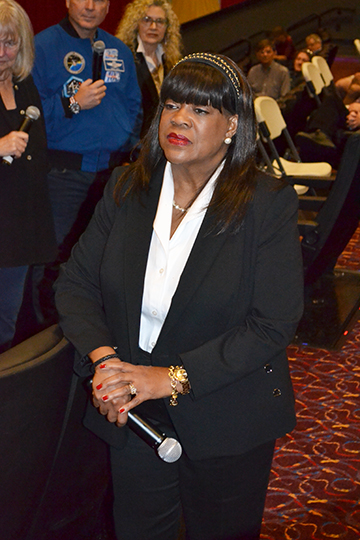
Chaz Ebert at the post-screening Q&A session.
While sharing, Ebert related an anecdote about Buckminster Fuller. When people would say “Hello,” to him, “he wouldn’t respond, ‘Hello,’ or ‘How are you?’ He would say, "I see you." According to Ebert, “He recognized that there is a very human need to be seen, heard, understood, respected, loved.” She then added that she hoped the event would help to foster this mindset.
Having had lots of experience with both Science on the Screen and being “above,” former NASA astronaut Terry Virts ignited the crowd by sharing about his experiences as an astronaut, commander of Expedition 43 on the International Space Station (ISS), and as one of the primary cinematographers of A Beautiful Planet. Regaling the assembly with stories about his experiences, he shared what living on the ISS was like, challenges of filming the movie, and the camaraderie that developed among the astronauts of different nationalities…despite simultaneous political tensions on earth.
Virts also shared how being in space had changed him and his perception of our planet’s interconnectedness. For instance, after describing a night view of Earth and the disparities between brightly lighted spots versus certain very dark sections, he shared that he had come to this realization, “I wasn’t seeing population; I was seeing wealth.”
Part of what made Virts’ participation in the symposiuim so special was his sense of humor. For instance, when a member of the audience commented that it takes a special person to be an astronaut, Virts responded: “You said it takes a special person. I think that's the kind of person who's crazy." In response to another query as to whether he might run for president, Virts quipped, “Do you have a fork? Would you mind sticking it in my eye?”
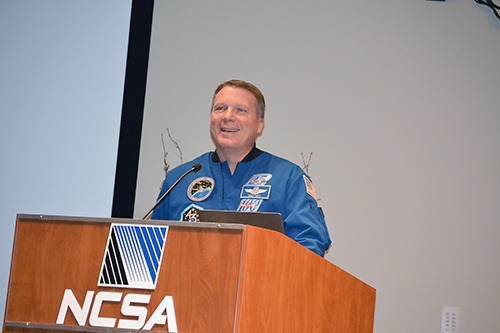
Terry Virts speaking at the Ebert Symposium.
Drawing on Virts’ expertise, a member of the audience asked where mankind should go next in space. “I think the moon is a great place to go first, as a testing ground,” he explained. “Humans haven’t been to the moon since 1972, so to say that, ‘We’ve been to the moon’…well, I haven’t been to the moon; nobody working at NASA has been to the moon! So I think it’s a good place as a build-up approach to test, but I think Mars would be the long-term space goal.”
Sharing what filming a movie in space was like while being stuck on the Earth, iMAX filmmaker Toni Myers indicated that she’d developed a “scene list” of all the shots Virts and the other astronauts should try to get…with this one caveat: “If an alien does come up and stick his face in the window, don’t not shoot it because it’s not on the scene list!”
Also sharing about space from an astrophysicist’s perspective was “Astro Katie” Mack. She shares why she agreed to participate in the symposium: “The idea of empathy and emotion in science communication is a huge thing for me,” she says. “It's a big focus of what I try and do is to sort of create connections between people and help people connect to the broader universe. So the idea of an event that's empathy for the universe sounded like the perfect kind of thing.” Plus, after looking the lineup of presenters, she added “And there are all of these amazing, talented people doing incredible things, so I was very honored to be included in that.”
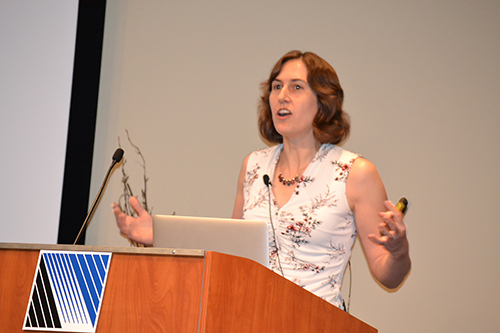
Katie Mack speaking at the Ebert Symposium.
Drawing from her vast wealth of knowledge about space, Mack shared a few absolutes about the universe. For one, it’s expanding. “We are currently 15.8 billion years into it,” she explains. “Star formation in the universe peaked about 9 billion years ago, and the expansion of the universe is accelerating,” she explained. “Something called dark energy—we don't know what it is—is stretching out the compounds and making the expansion speed up and pulling galaxies farther apart from one another.”
Mack says there's no center of the universe. “Unless you think, well, technically, we are each the centers of our own observable universe,” she equivocates. Plus, when we look out into the cosmos, she says we're looking back in time. This idea, along with her statement as to whether “now” actually exists inspired a lot of good-natured banter back and forth between presenters.
"It's so subjective,” she explains. “You can't define 'now' for any more than one person. When you study relativity, you lose the concept of now. So you have to figure out, when you say now, are you talking about the time the light arrives at my eye or am I talking about if I were able to stop the evolution of the universe at this moment everywhere, which can't be done. It get really, really complicated really quickly."
Also, according to Mack, the prognosis for the universe isn’t good: “Stars will die; black holes will evaporate. The universe will become a cold, dark, and empty place. It's called the heat death. It's inescapable.” The good news? “We're not there yet!” she shares, indicating that the end of everything is still billions of years away.
At the end of Mack’s presentation, she shared her poem, Disorientation with the audience. It perfectly expressed her philosophy about space, from the first line, “I want to make you dizzy,” to the one where she admits there might be life out there, “I want the sky to stop you dead in your tracks on your walk home tonight, because as you happened to glance up and among all the shining pinpricks, you recognized one as of the light of an alien world,” to the notion that man-made lines of demarcation separating humankind from one another are nonexistent from space:
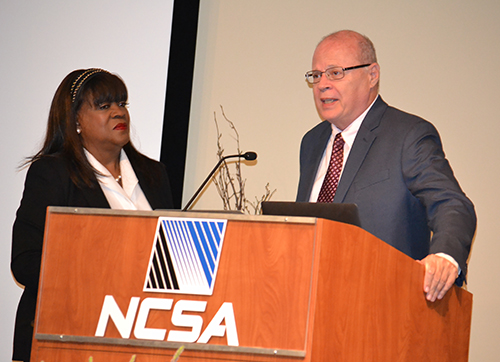
Chaz Ebert (left) and Nate Kohn (right) at the Ebert Symposium.
“I want you to see your world from four billion miles away, a tiny glint of blue in the sharp white light of an ordinary star in the darkness. I want you to try to make out the boundaries of your nation from that vantage point, and fail.”
Regarding Story Framing and Visualization, Illinois Computer Science Professor Karrie Karahalios reflected on the gist of what she and her colleagues were seeking to communicate: “People can actually relate better to stories than to facts. We have seen signs that visualizations actually help sway people…People can relate to a story that has a beginning, a middle, and an end, where they can connect the dots, especially a story they can relate to."
Illinois Journalism Professor Brant Houston stated, “Visualization of data is an integral part of journalism now,” then showed various examples of visualization, looking at some of the different ways journalists are telling stories and trying to establish the role of empathy.
Another concept this panel sought to convey was to beware of titles, as they often reflect the bias of the journalist or author or lead to incorrect assumptions. As an example of the inaccuracy of titles, Karahalios discussed the “Global Warming” label. “There has been a lot of debate about why scientists chose the term global warming early-on as opposed to climate change or changes in climate. Because people think global warming, and they're like, 'Well, it's below 0 outside, it must not be true.'”
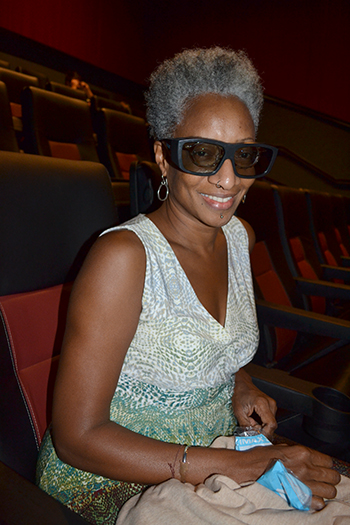
Cynthia Oliver, Associate Vice Chancellor for Research in the Humanities, Arts, and Related Fields, dons her 3D glasses in preparation for watching A beautiful Planet.
The pièce de résistance of the entire day, of course, was the screening of A Beautiful Planet in 3D at the Savoy 16 iMAX. Andreas Cangellaris, the Vice Chancellor for Academic Affairs and Provost summed it up when he called it “the kind of movie, the kind of visual experience that should be prerequisite reading or viewing for everyone.”
The post-screening Q&A session gave the viewers the opportunity to ask Virts and Myers questions that had been generated while viewing A Beautiful Planet.
One question viewers asked Virts was whether the night sky looks different now that he’s back on earth. “I look at a very different sky,” he admits, regarding the view from space. “You can't see it here…the light…the air. If you ever go to the Rockies or the Sierra Nevada mountains, it's awesome. But it's nothing compared to up there."
As Astro Katie alluded to in her poem, from space, one can’t see the borders of nations. Virts commented on his changed perspective in this regard: "I always feel like I'm home,” he admits, regarding being back on earth. “I never feel like I'm in a foreign country. Whenever I travel, I feel like I'm always home because I'm on Earth."
When asked how he became an astronaut, Virts acknowledged that he’d wanted to be an astronaut even as a young child. "When I was 5, the first book I read was about Apollo. One of the cardboard books with one line on it. I grew up with pictures of airplanes and galaxies on all my walls. I knew I wanted to do this since I was little,” he admits. “I was really lucky in that I got to do it!"
Regarding whether space exploration is worth the cost, Virts shared an anecdote. “Scientists working at Fermi Lab were being asked, ‘How does this contribute to the national defense?’ They responded by saying, ‘It makes the country worth defending.’ It is what makes us humans, our exploration,” Virts adds.
Story and photos by Elizabeth Innes, Communications Specialist, I-STEM Education Initiative.
More: NCSA, 2018
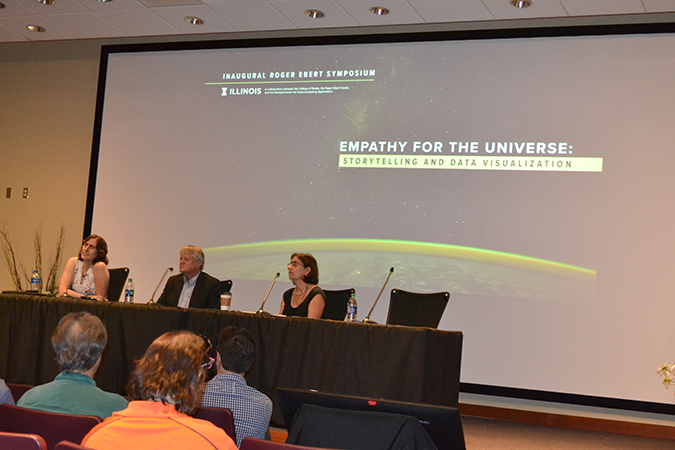 Speakers at the Ebert Symposium.
Speakers at the Ebert Symposium.













.jpg)
















